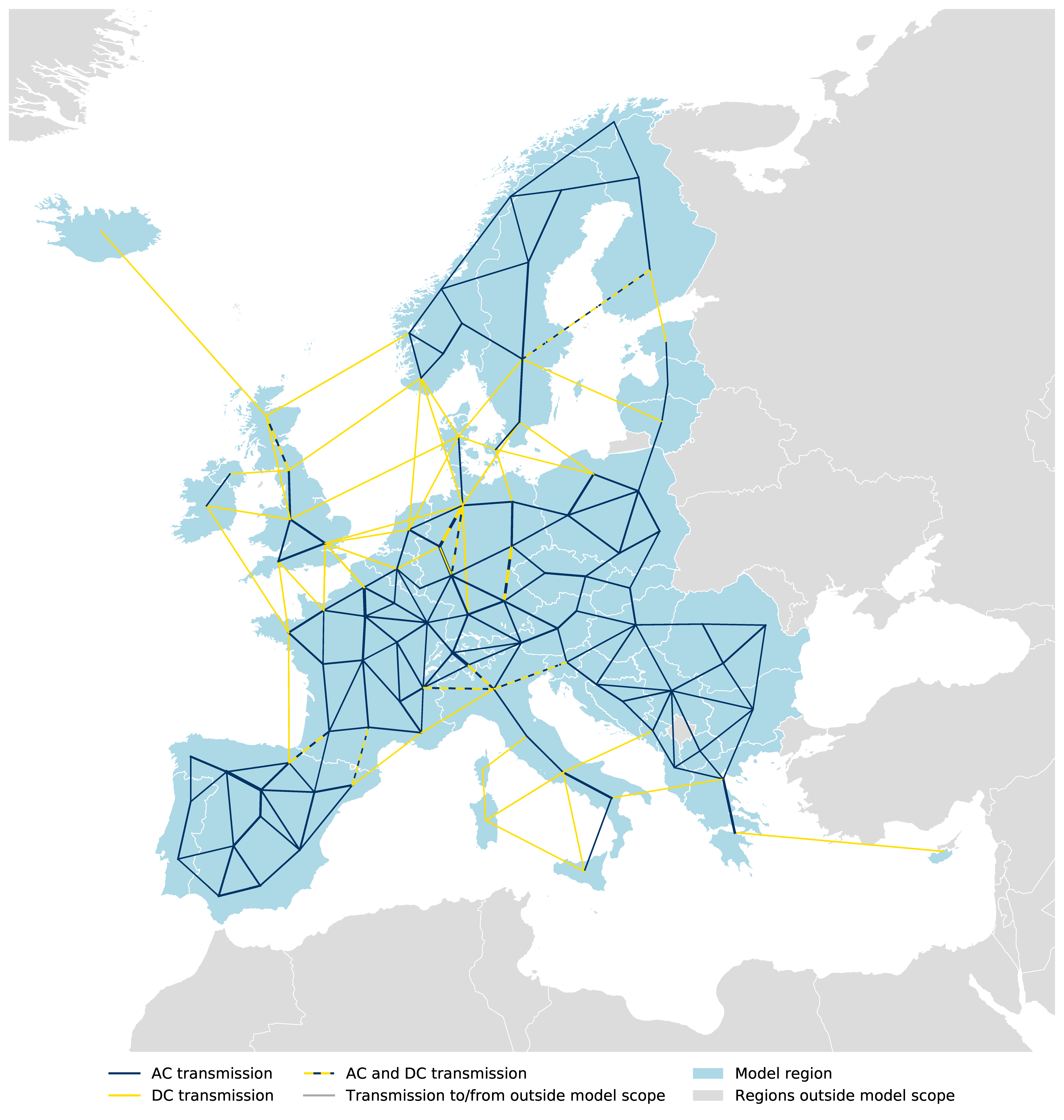Research
Calliope has been used in a variety of published studies on topics ranging from operational studies on small-scale urban districts to continent-wide decarbonisation scenarios. It is extensively tested and has withstood the test of peer review many times (see the list of publications below), so can serve as a solid foundation on top of which to rapidly develop a problem-specific model. Calliope is used not just in academic research, but also by commercial partners.
On this page:
- Some highlighted example applications of Calliope at different spatial scales and in different contexts.
- Details on Euro-Calliope, a series flagship models built with Calliope.
- An overview of other models built with Calliope.
- A list of publications using Calliope-powered models.
Example applications of Calliope

European energy system
We develop a range of European models: Euro-Calliope, a power-system-only model resolved to individual countries or to 497 first-level administrative subdivisions, and Sector-Coupled Euro-Calliope, resolved to 98 nodes and covering all end-use demands of energy as well as industrial feedstocks.

Bangalore district-scale system
Bangalore-Calliope models an illustrative district in Bangalore, India. The model is focused on decision-making under uncsertain demand and national grid availability, by using scenario optimisation.
Used in Pickering and Choudhary (2021) and other studies. Available on GitHub.

NREL Engage graphical modeling tool
Engage™ is a highly accessible and flexible web-based energy planning model for rapid multi-sectoral scenario exploration, built on top of Calliope.
Its cloud-based shared data model, intuitive interface and visualization capabilities facilitate collaboration and communication among diverse stakeholder groups, teams, and experts modeling systems from district energy / microgrid to national scales.
See website and GitHub repo.

Brazilian offshore wind
The Brazil-Offshore Wind Model is purpose-built to examine the potential role of offshore wind deployment in the Brazilian power system. It is a good example of a model which does not aim to capture a "complete" system, but only those parts necessary to answer the question at hand.
Used in Borba et al. (2023). Available on Zenodo.
Euro-Calliope models
Developed partly by the core developers of Calliope itself, the Euro-Calliope provides two things:
- A set of automated data processing code to generate models of the European electricity and energy system.
- Various fully-ready Calliope models built with this code, which we call “pre-built models” or “pre-builts”.
Two versions of Euro-Calliope exist. First, a fully sector-coupled version which includes besides the electricity system also the transport, heat, and the industry sectors (including the use of non-energy feedstocks). Second, the power-sector only model on which the sector-coupled version builds, but which retains interesting features of its own - for example a more flexible spatial resolution.
Sector-coupled Euro-Calliope

The data processing code and its documentation is available at https://github.com/calliope-project/sector-coupled-euro-calliope.
Pre-built versions:
- The version used in the paper “Diversity of Options to Eliminate Fossil Fuels and Reach Carbon Neutrality across the Entire European Energy System”, (Pickering, Lombardi, and Pfenninger 2022) is on Zenodo.
Euro-Calliope (power sector only)

The data processing code and its documentation is available at https://euro-calliope.readthedocs.io/.
Pre-builts are available at https://doi.org/10.5281/zenodo.3949553.
Models
These are some of the models built with Calliope by the core Calliope team and its partners, or models that we are aware of. Add your model directly with a pull request or contact us if you have a model that you would like to be listed here. Also see the examples highlighted above!
- Calliope-Italy. A model of the Italian energy system adopting a double spatial scale: renewable and heat generation is modelled across 20 regions based on region-specific weather conditions and potentials, whilst dispatchable capacity and transmission bottlenecks are grouped by the 6 bidding zones of the Italian electricity market. → GitHub.
- UK-Calliope. A 20-zone model of the power system of Great Britain (England, Scotland, Wales), with 20 years of validated hourly wind and PV generation data, used in several peer-reviewed publications. → GitHub.
- SA-Calliope. Used in a peer-reviewed paper comparing concentrating solar power (CSP) and nuclear as baseload providers in South Africa. It contains commercially licensed data and is thus not freely and publicly available. Email for access and more information.
- Cambridge-Calliope. Models a new development at the district level in Cambridge (UK). It focuses on optimising system design under uncertain demand. → GitHub
- Calliope-Kenya. Calliope-Kenya is a five-region model of Kenya developed at Politecnico di Milano. → GitHub.
Publications
This section lists the publicly available work based on Calliope which we are aware of. Add your publications directly with a pull request or contact us if you have a publication that you would like to be listed here.
Priyanka Laha and Basab Chakraborty (2021). Cost optimal combinations of storage technologies for maximizing renewable integration in Indian power system by 2040: Multi-region approach. Renewable Energy. doi: 10.1016/j.renene.2021.07.027
Bryn Pickering and Ruchi Choudhary (2021). Quantifying resilience in energy systems with out-of-sample testing. Applied Energy. doi: 10.1016/j.apenergy.2021.116465
Guilherme Pontes Luz and Rodrigo Amaro e Silva (2021). Modeling Energy Communities with Collective Photovoltaic Self-Consumption: Synergies between a Small City and a Winery in Portugal. Energies. doi: 10.3390/en14020323
Simon Morgenthaler, Christopher Ball, Jan Koj, Wilhelm Kuckshinrichs and Dirk Witthaut (2020). Site-dependent levelized cost assessment for fully renewable Power-to-Methane systems. Energy Conversion and Management. doi: 10.1016/j.enconman.2020.113150
Tim Tröndle, Johan Lilliestam, Stefano Marelli and Stefan Pfenninger (2020). Trade-offs between geographic scale, cost, and infrastructure requirements for fully renewable electricity in Europe. Joule. doi: 10.1016/j.joule.2020.07.018
Tim Tröndle (2020). Supply-side options to reduce land requirements of fully renewable electricity in Europe. PLOS ONE. doi: 10.1371/journal.pone.0236958
Francesco Lombardi, Bryn Pickering, Emanuela Colombo and Stefan Pfenninger (2020). Policy decision support for renewables deployment through spatially explicit practically optimal alternatives. Joule. doi: 10.1016/j.joule.2020.08.002
Francesco Lombardi, Sylvain Quoilin and Emanuela Colombo (2020). Modelling distributed Power-to-Heat technologies as a flexibility option for smart heat-electricity integration. Proceedings of the 33rd ECOS Conference, Osaka, Japan, July 2020. PDF link
Simon Morgenthaler, Wilhelm Kuckshinrichs and Dirk Witthaut (2020). Optimal system layout and locations for fully renewable high temperature co-electrolysis. Applied Energy. doi: 10.1016/j.apenergy.2019.114218
C. Del Pero, F. Leonforte, F. Lombardi, N. Stevanato, J. Barbieri, N. Aste, H. Huerto, E. Colombo (2019). Modelling Of An Integrated Multi-Energy System For A Nearly Zero Energy Smart District. 2019 International Conference on Clean Electrical Power (ICCEP) (pp. 246–252). doi: 10.1109/ICCEP.2019.8890129
Adriaan Hilbers, David Brayshaw and Axel Gandy (2019). Importance subsampling: improving power system planning under climate-based uncertainty. Applied Energy. doi: 10.1016/j.apenergy.2019.04.110
Francesco Lombardi, Matteo Vincenzo Rocco and Emanuela Colombo (2019). A multi-layer energy modelling methodology to assess the impact of heat-electricity integration strategies: the case of the residential cooking sector in Italy. Energy. doi: 10.1016/j.energy.2019.01.004
Bryn Pickering and Ruchi Choudhary (2019). District energy system optimisation under uncertain demand: Handling data-driven stochastic profiles. Applied Energy. doi: 10.1016/j.apenergy.2018.12.037
Bryn Pickering and Ruchi Choudhary (2018). Mitigating risk in district-level energy investment decisions by scenario optimisation, in: Proceedings of BSO 2018. Presented at the 4th Building Simulation and Optimization Conference, Cambridge, UK, pp. 38–45. PDF in Conference proceedings
Bryn Pickering and Ruchi Choudhary (2017). Applying Piecewise Linear Characteristic Curves in District Energy Optimisation. Proceedings of the 30th ECOS Conference, San Diego, CA, 2-6 July 2017. PDF link
Stefan Pfenninger (2017). Dealing with multiple decades of hourly wind and PV time series in energy models: a comparison of methods to reduce time resolution and the planning implications of inter-annual variability. Applied Energy. doi: 10.1016/j.apenergy.2017.03.051
Paula Díaz Redondo, Oscar Van Vliet and Anthony Patt (2017). Do We Need Gas as a Bridging Fuel? A Case Study of the Electricity System of Switzerland. Energies, 10 (7), p. 861. doi: 10.3390/en10070861
Paula Díaz Redondo and Oscar Van Vliet (2016). Modelling the Energy Future of Switzerland after the Phase Out of Nuclear Power Plants. Energy Procedia. doi: 10.1016/j.egypro.2015.07.843
Mercè Labordena and Johan Lilliestam (2015). Cost and Transmission Requirements for Reliable Solar Electricity from Deserts in China and the United States. Energy Procedia. doi: 10.1016/j.egypro.2015.07.850
Stefan Pfenninger and James Keirstead (2015). Renewables, nuclear, or fossil fuels? Comparing scenarios for the Great Britain electricity system. Applied Energy, 152, pp. 83-93. doi: 10.1016/j.apenergy.2015.04.102
Stefan Pfenninger and James Keirstead (2015). Comparing concentrating solar and nuclear power as baseload providers using the example of South Africa. Energy. doi: 10.1016/j.energy.2015.04.077